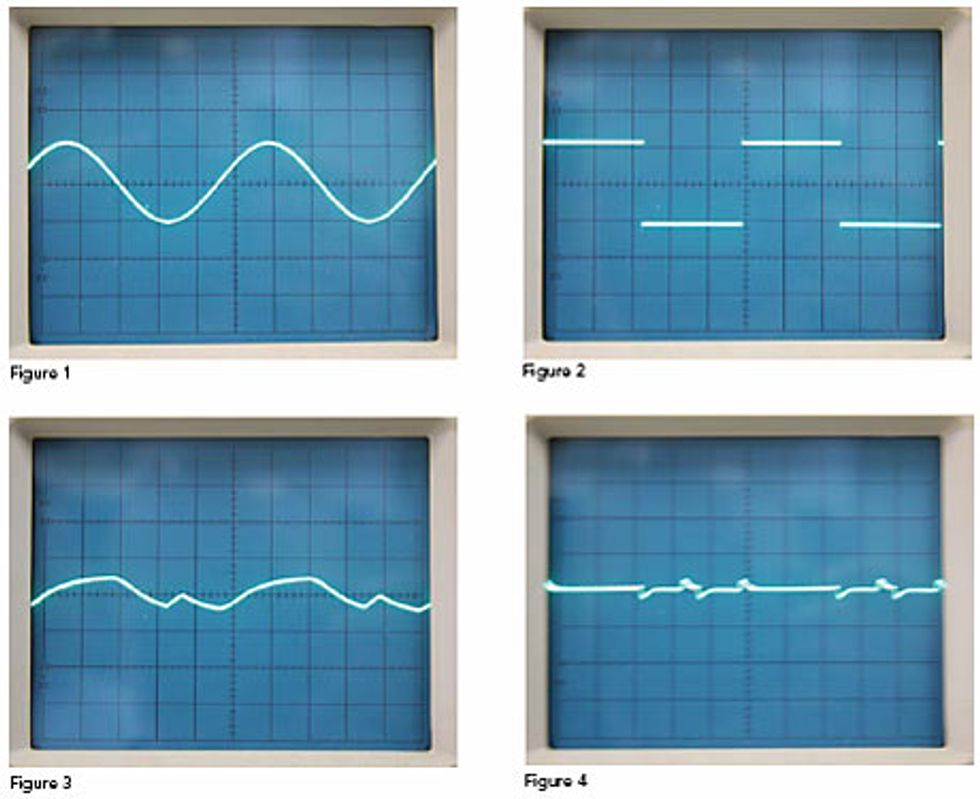In last month’s column, we looked at images of sound waves with and without distortion. I’d like to examine those photos again for some more analysis. In Figures 1
In last month’s column, we looked at images of sound waves with and without distortion. I’d like to examine those photos again for some more analysis.
In Figures 1 and 2 we can see that the waveforms have about the same amplitude (vertical height when viewed on an oscilloscope). Amplitude corresponds to the size of the signal in volts or electrical strength, thus the bigger the waveform the louder the signal. This is a general rule and there are always exceptions – test equipment can be set to see things in many different ways. However, for this discussion, remember that a bigger wave represents a louder signal.
In Figure 1 we have a nice, round sine wave. This represents a clean signal with no distortion. Figure 2 shows a square wave and believe me, it is nasty sounding. In the lab, we “look” at audio gear with a square wave running through it. A square wave, although not pleasing to the ears, can visually represent how a particular piece of gear is performing; in this case, the squarer the wave is, the better the gear is passing the signal without altering it. For applications requiring pristine audio, the wave should be very sharp and uniform. Introduce EQ, filtering, overdrive or distortion and the wave begins to take on non-linear shapes.
A particular piece of gear or its components all have a limit on how much signal, voltage and amperage that they can handle accurately. After a certain point, distortion begins to occur. If we were to add to the signal level in Figure 1, there would come a point that the gear could no longer handle the increase and the sine wave would begin to flatten and take on the appearance of the square wave in Figure 2. In this case we would be overdriving the limits of the particular piece of equipment or the component’s ability to cleanly pass the signal, thus the term “overdrive.” Overdrive is the easiest way to cause distortion.

Looking at Figures 3 and 4 we can see how a pedal affects the signal. Milder distortion is shown in Figure 3 and total annihilation of the signal is shown in Figure 4. In Figure 4 we see total compression of the waveform; the amplitude is diminished as compared to the wave in Figure 1. Although the wave is smashed down, it is very rich in harmonic frequency content and can sound as loud as the sine wave in Figure 1. Figure 4’s wave shows the same fundamental frequency as in Figure 1, except with about a zillion harmonic derivatives induced by the pedal’s circuitry. While amplitude is relative to loudness, so is the complexity and harmonic content of a signal.
Distortion and overdrive pedals basically derive their sounds by two types of processing. The first and easiest way is to increase the gain (amplitude) of the signal. The second way is to change the shape of the original signal by adding, subtracting, filtering, etc. We can use transistor gain staging, diode clipping, harmonic regeneration/feedback, opto circuit manipulation and many other exotic circuit derivatives to cause distortion. However, it should be noted that both methods come with a price; overdrive or distortion obtained by a function of gain usually has a corresponding increase in noise, while circuit manipulation of a signal is often described as “tone sucking” and alters the original sound of the signal.
Great examples of this are FET transistorbased pedals (the typical “Tube Screamer” type of pedal). FETs are an easy and inexpensive way to obtain gain, but they get noisy as the gain increases. They also produce a loss of low-end frequency response, mid frequency peaking and harshness in the upper frequencies. The gain increase and mid boost is killer for pushing a 100-watt amp into orbit for a solo, but the loss of low-end response and increased noise is not acceptable for bass players. Note: Many Tube Screamer-type pedals have IC chips as their major component (in particular the beloved 4558), but the chips are based on FET technology.
And always remember the basic premise of overdrive and distortion: when you are practicing by yourself soak it up to the top, but cut it way back when you get with the band.
Come see us at the Orlando, Nashville, Spartanburg, Dallas, and Summer NAMM shows where the boys and I can give you an earful. We enjoy teaching, ‘cause rock n’ roll ain’t noise pollution (most of the time)!
Sarge out.
Gary "Sarge" Gistinger
President, Creation Audio Labs, Inc.
creationaudiolabs.com
